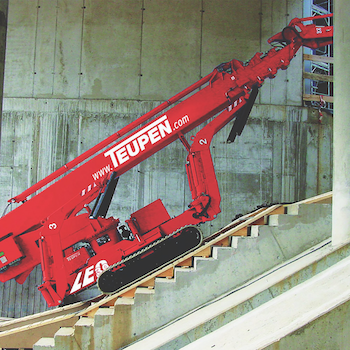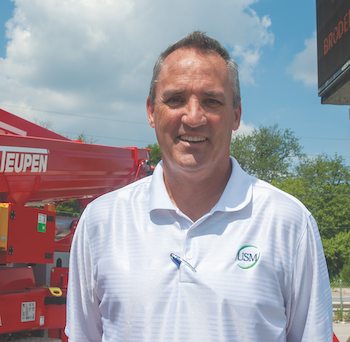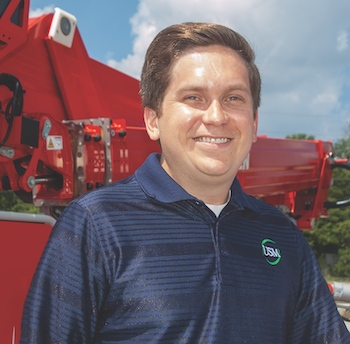Rental Center: Fill the gaps
USM ReRents helps rental centers fill in the gaps in their fleet without breaking the bank.
by Clair Urbain
 |
| MEWPs such as this Teupen unit are in USM ReRent's fleet that are only available to other rental centers to rerent to their customers. |
 |
| “Our motto is, ‘Don’t lose the deal if you don’t have the steel.’ It’s catchy and it’s true,” says Tom Saxelby, vice president of sales at USM ReRents located in Elmhurst, Illinois. |
 |
|
“We don’t rent to the guy that will physically touch it, we rent it to a rental house that re-rents it to their customer. We’re here to supply them, not compete with them,” says Keith Serbin, “If a rental house is bidding on a job where they might need five units and they only have three, we can backfill them with two more. Instead of buying them, they can rent from us and then use their CAPEX and OPEX for other needs.” |
“Our motto is, ‘Don’t lose the deal if you don’t have the steel.’ It’s catchy and it’s true,” says Tom Saxelby, vice president of sales at USM ReRents located in Elmhurst, Illinois.
The company opened its doors in 1990 with a new approach to the rental business. Originally named US Markets/USM Rentals, it set sights on being a wholesale renter of sorts to rental houses across North America. Presently, it has more than 600 units in its re-rent program.
“We were the first one to develop that concept and implement it,” says Saxelby. “We actually were the first company to get into re-rentals for aerial high-lift equipment and forklifts from 10,000 to 20,000 pounds.”
Until recently, the company went by the name of U.S. Markets, but it faced an identity issue. “Customers would try to reach us through search engines and would end up getting lists of financial companies that dealt with stocks and bonds. We think USM ReRents more correctly identifies who we are and what we do,” says Saxelby.
The company first envisioned itself as a manufacturer rep but decided to explore the re-rent market with smaller scissor lifts. Over time, their fleet has morphed into larger boom-style units as well as specialty equipment that can get into tight areas. “Today, the fleet is primarily made up of 80- to 185-foot boom lifts, compact crawler lifts with reaches ranging from 43 to 175 feet, telehandlers ranging from 8,000 to 20,000 pounds, 1,600 cfm portable air compressors and mini cranes. We have a few other pieces of equipment as well, but most of our fleet is lifting equipment,” says Keith Serbin, USM ReRents operations and customer success director.
Renting only to rental houses
“We don’t rent to the guy that will physically touch it, we rent it to a rental house that re-rents it to their customer. We’re here to supply them, not compete with them,” says Serbin, “If a rental house is bidding on a job where they might need five units and they only have three, we can backfill them with two more. Instead of buying them, they can rent from us and then use their CAPEX and OPEX for other needs.”
“It’s a true partnership. We rent to all major consolidators, as well as regional rental companies, and independent rental centers. But we do not go to the end user. We never rent to the end user. We always partner with rental companies,” Saxelby adds.
Test the market
USM ReRents offers rental companies a way to put their toe in the water of a market they have not yet served. “Let’s say a rental company is trying to extend its footprint. We can help them learn the market by providing them with a few units that they can rent to end users. They can test the new units and find out the utilization they have to see if this type of equipment is something they may want to add to their fleet or continue to re-rent if utilization numbers are not there. They can consider it an option and not have to say ‘no’ to their customer and don’t have to use their own capital expenses.” Serbin says.
|
USM ReRents Falcon Genie Jekko JLG Magni MEC Skyjack Sullair Teupen |
How it works
USM ReRents has developed five regions in the United States and another one in Canada. Periodically, it sends out messages to communicate what equipment is available to rent in each geographic area. “We send out messages via social media and email blasts. Ideally, we’d like to keep the equipment within a region, because it gets expensive to ship that equipment very far,” says Saxelby. “Sometimes, a machine goes off rent at one rental center, then gets picked up by the competitor across town and re-rented because it has a customer needing that unit.”
The re-rental units’ owner is completely transparent to the customer and end user. “We don’t have any signage on the equipment that shows it is a USM ReRents unit. In fact, most rental houses place their own sticker on the machine while they have it rented out,” adds Serbin.
With nearly 1,000 customers in the United States and several dozen in Canada, Saxelby says the awareness of USM ReRents across rental centers varies greatly. “Some rental companies are very familiar with us and use us often, but on the other end of the spectrum there are rental companies who have not heard of the re-rent concept and we need to help them understand the concept and how it can benefit their business.”
Survival strategy
As the coronavirus pandemic works its way through the country, utilizing a re-rental strategy could help rental companies of all sizes free up funds, Serbin says. “If you save your CAPEX, you’re in a better position to keep employees and be able to pay them. In tough times, re-rental can help you fill equipment requests. It’s a way for you to not say ‘no’,” Serbin says. “When a front-desk guy gets a call for that 150-foot aerial lift, he doesn’t need to say that you don’t have one. Instead, you have it available through us.”
Serbin and Saxelby report one of the most active pieces of re-rental equipment recently have been spider lifts. “When we started in 1990, to where we are today, we went through a maturation process of trying to figure out what made sense for our company and what made sense for the partners or the rental companies we serve. We have evolved to a place where we now supply equipment that we can make a return on invested capital and the customer can make a return as well. We finally found that sweet spot. That’s how we’ve evolved into 80 foot and higher aerial lifts, 10,000 pounds and greater telehandlers; and the spider lifts have been outstanding,” Saxelby says. “We’ve also had great interest with Jekko mini cranes, which can be used on uneven ground and tight areas and are light in weight. They can be offset and outfitted with a suction-cup attachment for positioning big panes of glass. These mini cranes help our aerial lift customers branch out into other areas. We’ve also had great interest in Magni units that have 360-degree fork masts that can reach five stories high.”
Newer, smarter fleet
“Most of our units are less than 36 months old and at one point last year, our average fleet age is under 30 months. They are all outfitted with Topcon and ZTR telematics, which works with the telematics systems aerial lift manufacturers are using on their equipment,” says Serbin.
“More manufacturers are starting to get into the telematics space. They can give us intuitive information on the equipment, not just geofencing. We can see real-time performance data on each machine. It allows us to see if there are problems on the horizon. It also helps the manufacturer, because it gives them insight on machine performance and if there are issues with certain part or other problems,” says Saxelby.
Although the re-rental business is appealing to USM ReRents, Saxelby says there are some high barriers to entry. “I think the reason this isn’t a populated space is because it takes a lot of capital to get into this business. We need to be very confident in the manufacturers we work with. They must have dependable units and great parts and service capability to assure these machines are available. If a machine goes down and can’t be fixed right away or parts aren’t available, it reflects poorly on the rental companies, and then on us and also the manufacturer. It’s a ripple effect.”
Raising awareness
Although the company has been around since 1990, Saxelby says not every equipment rental company is aware of its services. “It’s very interesting. We have customers who are extremely aware of us, and then there are others who we talk to ask, ‘Wait, explain this concept to us again?’ They literally have no idea that we’re out there or what we do. It’s a partnership. We couldn’t run this if we didn’t have trust in our customers and they didn’t trust us. The minute we sell to an end user or work with an end user, this business model is over!”
USM ReRents actively brokers its equipment for sale, as well as provides brokerage services for other clients. “We have found that if our inventory gets too long in the tooth, our customers don’t want it. Our goal is to continuously refresh our fleet,” Saxelby says.
-30-
This article originally appeared in the September-October 2020 issue of Pro Contractor Rentals magazine. ©2020 Urbain Communications LLC.








